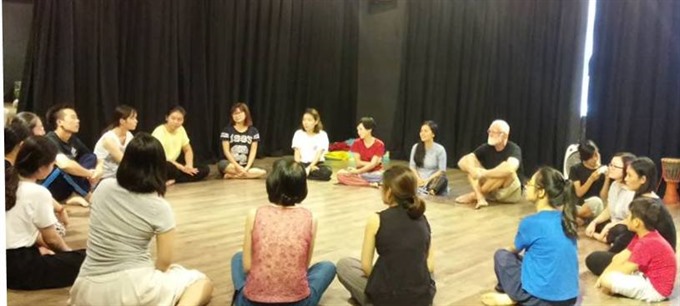 Life & Style
Life & Style

Douglas Holwerda, a psychotherapist whose primary work is talk therapy for those who are dealing with life problems or mental health issues, never planned to move to Việt Nam—but now he’s lived here since 2011.
 |
| Dr Douglas Holwerda sits at the centre during a workshop which uses dance/movement as a practical way to balance will power and acceptance, deal with expectations and aspirations, and above all, to increase awareness and thrive. — Photo courtesy of Dance/Movement group |
by Minh Thu
American psychotherapist Douglas Holwerda, whose primary work is talk therapy for those who are dealing with life problems or mental health issues, never planned to move to Việt Nam—but now he’s lived here since 2011.
Holwerda, first came to Việt
He returned to Việt
When he looks back on a decade of experience here, he still remembers his first impressions of Việt
“I do remember that I felt comfortable and welcome,” he adds.
“Now that I have lived in
“It is difficult to explain, but I feel a kind of freedom here that I do not feel in the
The once-daunting motorbike traffic has become a source of joy for him.
“Motorbike travel is so much better than sitting in a car stopped at a red light in a long line of traffic so familiar in
Living here has also enabled him to explore and grow within his profession, as he forms connections and introduces new psychotherapy programmes for Hanoians.
He has recently started offering a lecture series on “Empowerment”, designed to increase participants’ awareness of basic principles used in psychotherapy so that can they can better know themselves, relate to others and find their place in the world.
 |
| Psychotherapist Douglas Holwerda. — VNS Photo Đoàn Tùng |
Dancing therapy helps cure
Holwerda feels very strongly about the creative process. He stresses that one of the ways that people find healing is through creative expression and a playful attitude. “It helps us to live in our bodies, to be present, to explore new and different aspects of ourselves, overcome inhibitions, to connect with others and to enjoy living life.”
“I almost always feel better after I have participated in some creative activity, whether it is dance and movement or singing or painting or just playing. I think it has value for all people and I am happy when I see those who try it and discover some joy in the process. So many people think, ‘I am not creative.’ But don’t realise that they really are if they let go and enjoy experimenting with new things.”
Over the past few years Holwerda has organised many workshops and lectures about this type of therapy, along with dancer Bùi Tuyết Minh, the leader of the Dance/Movement therapy group in Hà Nội.
He developed “Creative Play”, which is now part of the Dance/Movement therapy group, in
They experimented with it together for six years almost every week and came to see it as a way to learn how to be spontaneous, less inhibited and more light-hearted. They could also see that it rubbed off onto other aspects of their lives.
Over the past few years Holwerda and his partners in the Dance/Movement group have introduced these ideas to interested people in a series of workshops. He said, “I love to see people playing with movement and sound. It is amazing to see how fun it is to explore the corners of what is possible. I also love to play with balloons… they almost always bring a smile to those who are playing with them.”
Holwerda leaves Việt
“For me the creative side of myself keeps me in touch with my inner child, free to be spontaneous and find joy in the simple things of life. I feel empowered to just be myself. I also think it helps me be a better psychotherapist, present to others in ways that are helpful.” — VNS




